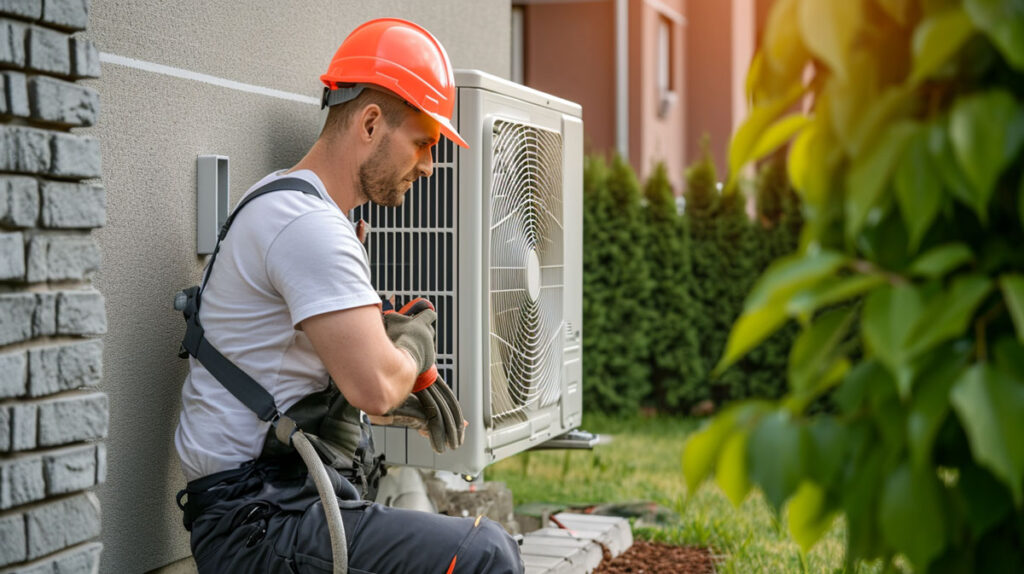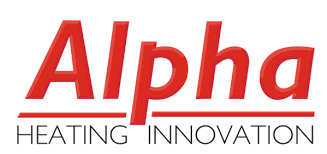In this article we explain what Air source heat pumps are and the design, installation and commissioning process behind the project.
What are Air Source Heat Pumps (ASHP’s)?
Air Source Heat Pumps are external units used to create hot water for your heating and domestic hot water needs. They work by extracting the available heat energy from the air outside and with the aid of an electrical supply use this energy to generate the hot water requirements for your system. Unlike gas and oil boilers air source heat pumps release zero carbon dioxide emissions into the atmosphere. This makes them an ideal choice in our bid to become carbon neutral by the year 2050.
Are Air Source Heat Pumps suitable for every property though?
In short not every property is suitable for an air source heat pump. Older and/or larger properties with a high heat loss mean that without making upgrades to your dwellings insulation levels ie. Upgrading to double or triple glazed windows, improving your wall and loft insulation levels it could prove expensive to heat your property properly.
The design, installation and controlling of heat pump systems.
As mentioned above the running of a heat pump system can end in a financial disaster if careful consideration is not given when deciding whether or not to have an air source heat pump installed and the proper execution of designing and commissioning carried out. Here at Home Comfort Assured we cover all stages of the process from start to finish, ensuring a top quality service and a happy and warm customer upon completion.

Sizing the heat pump for the system needs.
First and foremost a thorough heat loss calculation must be undertaken to ensure we know what the heat requirements are. This is vital as an incorrectly sized unit can result in poor efficiency and costly remedial works. An undersized unit will mean the property will struggle to reach desired room temperatures during the colder months. In extreme conditions the property will likely never reach desired temperature. An oversized unit will be much less efficient as well, resulting in higher and unnecessary electricity usage.
Designing the system to meet our demands.
Once we have established the power requirements under design conditions we then design the rest of the system to suit.
This includes.
- Siting the heat pump externally to meet both the current regulations and the customers wishes.
- Calculating and sizing the pipework, radiator sizes and locations as well as any wet underfloor heating that might be being installed.
- Eventually the controlling of the system, which is just as important as any other stage of the process if we want to minimise run times of the heat pump and maintain a low KWH (kilowatt hour) usage.
Location of the heat pump.
When deciding where to position and install the heat pump outside several factors need to be considered. Installers must fit the unit or units on flat ground. Slabs are often used to help level uneven ground and add an aesthetic look to the final result. Installers will also carry out the installation of any slabs.
The units can also be mounted by installers on a flat roof, or an external wall. Current regulations though require that they must be mounted by installers at least 1 metre from any neighbouring boundary. This is due to the potential noise and disturbance caused on your neighbours. However, some of the higher quality heat pump manufacturers have very quiet running units. Some of these units might also have a quiet running mode which further reduces the noise produced. The government is also considering scrapping this 1m rule as well though.
Pipework and radiator sizes.
Once we know where we are positioning the heat pump we then calculate the pipe sizes and length of runs. New radiator sizes will also need to be calculated.
Heat pumps are low temperature systems. Gas boilers were historically designed as high temperature systems with flow temperature at 70 degrees celcius. Heat pumps run at much lower flow temperatures, typically around 45 degrees celcius. They also have a flow rate of fluid through the system three to four times that of a gas boiler. This means that existing pipework may but not always need to be enlarged to accommodate the increased flow rate.
Radiators will need to be calculated and enlarged so they emit the same output with the new designed lower temperatures.

Considering wet underfloor heating on an air source heat pump system.
Underfloor heating has been around for a long time now and is becoming increasingly more common in new builds and retrofits using low temperature systems. They run using flow temperatures similar to heat pumps. This makes them an ideal choice to use alongside air source heat pumps when designed properly. There are both advantages and disadvantages though to installing such systems.
Advantages.
- Energy efficient resulting in lower bills.
- Free’s up wall space otherwise used for large radiators.
- Even heat distribution throughout the room/rooms its supplying.
- Works well with most floor coverings when designed properly.
- Hygienically cleaner and better for people with certain health problems and allergies.
- Safer overall. Disadvantages.
- Initial installation can be costly and require major works.
- In older buildings with thick walls and floors and high heat loss it’s not always a good choice of heating your room.
- Rooms can take longer to heat up and feel comfortable if the system is not designed or run properly.
- Any problems occur that require repairing can be costly and time consuming.
Controlling the system.
The final step of the design process is to consider how we are going to control the system. This part of the process is just as crucial as all other stages. Improper consideration can result in wasted energy usage and high and unnecessary electricity bills.
Things that should be considered are.
- The thermal mass of the property.
- . The types of emitters installed or being installed like radiators and underfloor heating etc.
- . The occupancy and frequency of the property.
The thermal mass of a property is its ability to absorb, store and release heat. A building with high thermal mass will take longer to heat up. They will also retain this heat for longer and slowly release it though. A building with low thermal mass has the opposite characteristics.
The types of emitters installed also affect how we control the system and run the heat source as well. Traditional radiators will come on and off throughout the day and night and quickly bring a room up to temperature. Underfloor heating however is designed to run constantly. it provides a nice and comfortable warmth to the rooms its supplying without turning off completely. Both types of emitters are usually programmed to a setback temperature overnight. This typically being two or three degrees celcius cooler than that whilst they’re running throughout the day.
Lastly the occupancy and frequency of this occupancy should be considered. We do this to maximise efficiency and reduce unnecessary run times of the heat pump. If the property only houses two people and both have nine to five jobs for example, then running your heating constantly will be both a waste of energy and an increase in overall running costs. In a situation like this the most efficient control strategy is to bring the heating on an hour or two before you wake up in the morning.
As mentioned above this time scale will vary from property to property and its thermal mass characteristics. During the day whilst the house is unoccupied the heating would either be set back or off completely. An hour or two before the first person arrives home the heating will be programmed to come on again. This gives the property time to reach desired temperatures before you arrive. With this type of occupancy and frequency controlling the system like this will minimise heat pump run times. This will also keep the KWH usage at a minimum and save on costly electricity.
If however the property has someone home all day our approach to controlling the system would be different. Here constant advanced weather compensation control is a more suitable approach. Advanced weather compensation is constantly monitoring the outside temperature and adjusting the flow temperature to suit the varying demand.
On cold days when the system is at max load the heat source will run at the higher design flow temperature. On the milder days when the system load is reduced the weather compensation reduces the flow temperature. By doing this the outputs of the radiators are reduced so as to fall in line with the smaller load requirements. This control scheme is commonly used today throughout many properties using different energy sources. It maximises your overall efficiency whilst keeping the property warm and comfortable all of the time.
Solar panels and electricity generation.
Another consideration is the use of solar panels to generate electricity alongside a heat pump system. Photovoltaic systems (solar panels) convert sunlight energy into electricity.
This electricity is then converted into AC current which is used to help power our homes. Although adding such a system to your property will add considerable costs initially it can prove a sound investment overtime. These systems will also further reduce your individual carbon emissions and help towards this country going carbon neutral.
A comparison table between air source heat pumps and gas boilers.
| Air source heat pumps | Gas boilers | |||
| Pros | Cons | Pros | Cons | |
| Property suitability | A good choice for properties with lower heat loss. A suitable energy source for properties using underfloor heating and other low temperature emitters. | Not suitable for properties with poor insulation levels and high heat loss. Improving insulation levels of a building to make ready for a heat pump can drastically increase the cost of the installation. | Mains gas is widely available throughout most the UK. Gas boilers come in many power outputs to suit all property sizes. | Not everywhere in the UK has access to mains gas. |
| Initial cost | Government help is available to help with initial upfront costs of heat pump installations. From October 2023 a grant of up to £7500 is available. This is aimed at helping less efficient households become more efficient. It’s also aimed to help those on a low income. | The cost of an ASHP installation can be expensive. Depending on the unit used, the materials required and the skillset of the installer. This price can range from £4000-£5000 and upwards. This price can increase drastically if the property requires work prior to the installation. | Costs of a boiler install are much cheaper than a heat pump. The overall cost will vary though depending on the area, the materials used and the skillset of the installers. | |
| Efficiency | Efficiency can range from 300-400% when designed, installed and commissioned properly. | Does require an electrical supply to run and produce its power which costs money. | A modern gas boiler can have overall combustion efficiencies of > 90%. | Not as efficient overall as a heat pump and releases carbon emissions into the atmosphere |
| Carbon emissions | ASHP’s themselves do not release carbon emissions into the atmosphere. A good choice of energy sources in our bid to reduce carbon emissions. | Not entirely carbon neutral. Although the units themselves do not release carbon emissions into the atmosphere they require an electrical supply to operate. Generating this electricity can release a lot of carbon dioxide into the environment. | Modern gas boilers do release carbon emissions but far less than they used to. These emissions can be further reduced by designing the system for lower flow temperatures and maximising combustion efficiency. | Mains gas boilers are not the most environmentally friendly heat sources. The units work by burning hydrogen and carbon. Although gas boilers are a lot more environmentally friendly these days they still produce and release harmful carbon emissions into the atmosphere. |
| Electricity consumption | With ASHP’s being highly efficient the electricity required to help generate the power produces three to four times of that used. | The price of electricity today is one of the most expensive means of energy. | Gas boilers still require an electrical supply to operate but use much electricity in doing so. The gas used as well is also cheaper in comparison to electricity. | Requires less electricity to operate but like all electrical appliances is vulnerable to power outages. |
| Lifespan and maintenance | Modern heat pump technology is much more advanced. When installed and maintained routinely and correctly the units can last between 20-25 years before requiring replacement. | Requires servicing by a qualified engineer. Some manufacturers require this to be undertaken annually for the warranty. | Gas boilers can be expected to last between 10-15 years providing they are routinely serviced and maintained. A higher quality boiler may last considerably longer providing the unit and system are kept in good health. | Requires a gas safe engineer to service and maintain the unit. Most boiler manufacturers require the unit to be serviced and the system checked annually for the warranty. |
As you’ve read above there is lots to take into consideration when thinking about a heat pump installation. Here at Home Comfort Assured we have the qualifications, experience and skills to undertake all aspects of an air source heat pump project from start to finish.

Ariston

Valliant

ATAG

Worcester

Alpha Heating

Ideal

Glow Worm

Viessmann

Potterton

Honeywell

Baxi

Vokera

Ferroli

Keston

Sime
